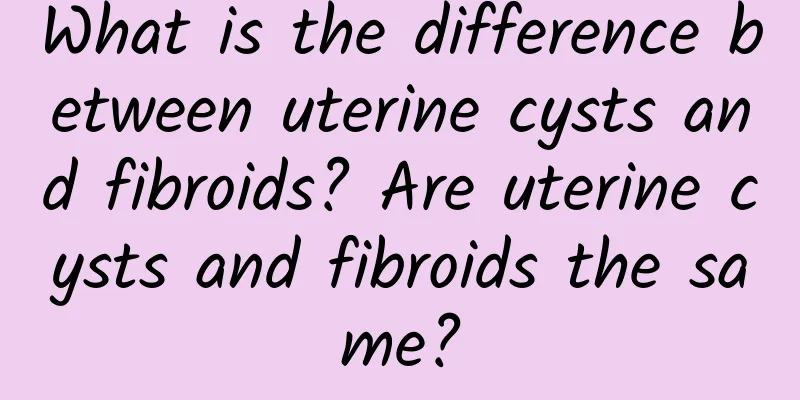What is the difference between uterine cysts and fibroids? Are uterine cysts and fibroids the same?

|
Uterine adenoma and fibroids are common gynecological diseases that can easily lead to uterine enlargement and irregular menstruation. However, many people are not clear about the difference between uterine adenoma and fibroids. This article will introduce the difference between these two diseases and provide relevant scientific knowledge. Let's understand the definitions of uterine adenoma and fibroids. Uterine adenoma refers to the formation of cysts caused by endometriosis, while fibroids are benign tumors that grow in the myometrium of the uterus. Although both can cause uterine enlargement and menstrual abnormalities, their causes and treatments are different. Regarding the causes, uterine adenoma is mainly caused by endometriosis, which is the growth of endometrial cells outside the myometrium. These cells are also affected by hormones during menstruation, causing abnormal proliferation of the endometrium and the formation of cysts. In contrast, fibroids are caused by abnormal growth of smooth muscle cells in the myometrium. This proliferation is usually related to genetic factors, hormone levels, and nutritional status. In terms of diagnosis and treatment, uterine adenoma can usually be confirmed through hysteroscopy, especially when symptoms such as irregular menstruation, menstrual cramps, and infertility are present. Once diagnosed, conventional treatment includes establishing normal hormone levels and local or complete removal of cysts. In contrast, the diagnosis of fibroids mainly relies on imaging examinations such as ultrasound and MRI. Patients with small fibroids usually do not need special treatment. For larger fibroids, doctors may recommend surgical removal or other interventions. To sum up, the difference between uterine adenoma and fibroids mainly focuses on the causes and treatment methods. Uterine adenoma is mainly a cyst formed by endometriosis, while fibroids are benign tumors that occur inside the uterine myometrium. In terms of diagnosis, uterine adenoma is usually diagnosed through hysteroscopy, while fibroids need to rely on imaging examination techniques such as ultrasound and MRI. In terms of treatment methods, the conventional method for uterine adenoma is mainly to remove the cyst, while for fibroids, specific treatment is required according to the size and symptoms of the fibroids. Uterine adenoma and fibroids are common gynecological diseases, especially in middle-aged women. Although these two diseases may cause similar symptoms, due to different causes and treatments, it is necessary to confirm the diagnosis and develop a corresponding treatment plan through the diagnosis and guidance of a doctor. Early detection and treatment of uterine adenoma and fibroids can effectively alleviate symptoms and reduce the risk of infertility or other fertility problems. Therefore, it is very important to have regular gynecological examinations to ensure women's health and well-being. |
<<: What foods are not suitable for people with uterine fibroids?
Recommend
I rarely have my period, I'm a bit scared, is there any way to change it?
I am a little scared of having very rare periods....
What should I do if I suddenly have heavy menstrual flow during menopause? Learn more about it early
If menstruation suddenly becomes heavy during men...
Does ovarian cyst affect pregnancy?
Will ovarian cysts affect pregnancy? Ovaries affe...
What should be paid attention to in the daily care of hyperprolactinemia?
Hyperprolactinemia is the most common pituitary d...
Primary dysmenorrhea can take the following care methods
Many people panic and don't know what to do a...
What are the causes and symptoms of adnexitis?
What are the causes and symptoms of adnexitis? Si...
What should I do if I find an ovarian cyst after pregnancy?
The pregnant mother was just immersed in joy when...
Where is a good hospital for cervical erosion?
Cervical erosion is a gynecological disease that ...
Who says you can only eat boiled meals to lose weight! Teach you how to make sesame oil and black fungus chicken breast, low fat, nutritious and good with rice
【Aijia Ancient Flavor】—Sesame Oil and Black Fungu...
Is diarrhea in early pregnancy a threat of miscarriage?
Diarrhea in early pregnancy is not a direct precu...
Can I still have a baby if I have pelvic effusion? Does it affect my pregnancy?
Can I still have a baby if I have pelvic effusion...
Heaven and man are in harmony! Traditional Chinese medicine health care is tailored to local conditions
Since ancient times, Chinese medicine has always ...
Experts review the diagnosis of acute pelvic inflammatory disease
What is the diagnosis of acute pelvic inflammator...
What is cervical hypertrophy?
Cervical hypertrophy is the enlargement of the fe...
How to diagnose adnexitis
How to diagnose adnexitis? Adnexitis is one of th...









